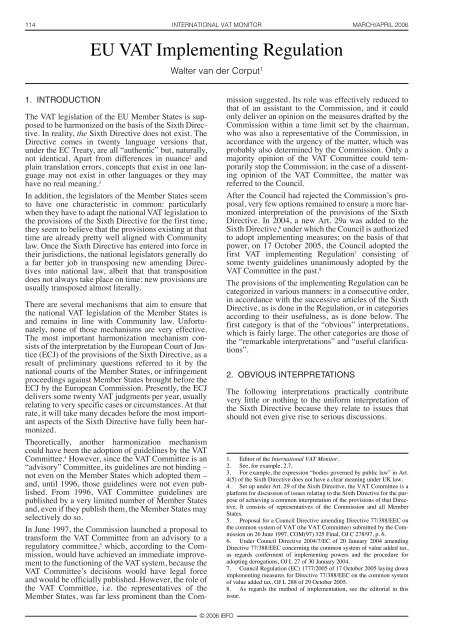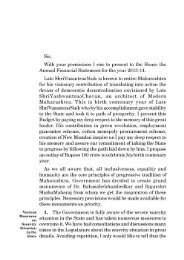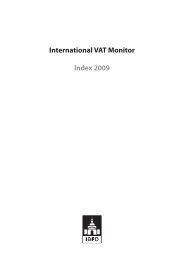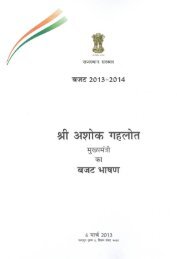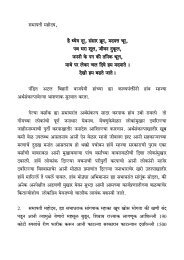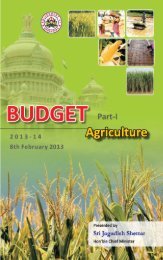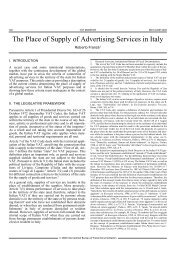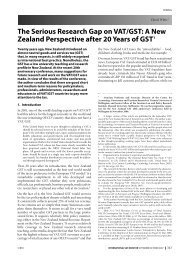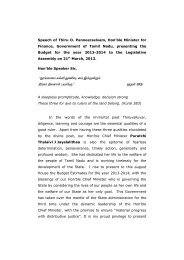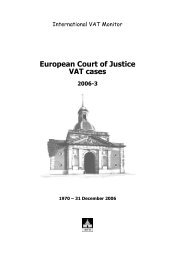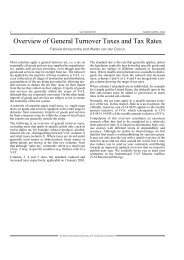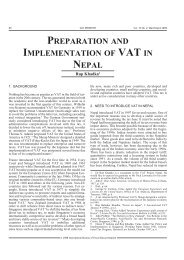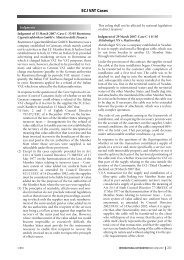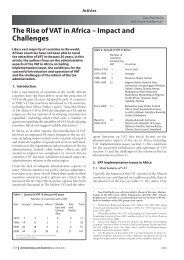EU VAT Implementing Regulation - empcom.gov.in
EU VAT Implementing Regulation - empcom.gov.in
EU VAT Implementing Regulation - empcom.gov.in
Create successful ePaper yourself
Turn your PDF publications into a flip-book with our unique Google optimized e-Paper software.
114 INTERNATIONAL <strong>VAT</strong> MONITOR MARCH/APRIL 2006<br />
1. INTRODUCTION<br />
<strong>EU</strong> <strong>VAT</strong> <strong>Implement<strong>in</strong>g</strong> <strong>Regulation</strong><br />
The <strong>VAT</strong> legislation of the <strong>EU</strong> Member States is supposed<br />
to be harmonized on the basis of the Sixth Directive.<br />
In reality, the Sixth Directive does not exist. The<br />
Directive comes <strong>in</strong> twenty language versions that,<br />
under the EC Treaty, are all “authentic” but, naturally,<br />
not identical. Apart from differences <strong>in</strong> nuance2 and<br />
pla<strong>in</strong> translation errors, concepts that exist <strong>in</strong> one language<br />
may not exist <strong>in</strong> other languages or they may<br />
have no real mean<strong>in</strong>g. 3<br />
In addition, the legislators of the Member States seem<br />
to have one characteristic <strong>in</strong> common: particularly<br />
when they have to adapt the national <strong>VAT</strong> legislation to<br />
the provisions of the Sixth Directive for the first time,<br />
they seem to believe that the provisions exist<strong>in</strong>g at that<br />
time are already pretty well aligned with Community<br />
law. Once the Sixth Directive has entered <strong>in</strong>to force <strong>in</strong><br />
their jurisdictions, the national legislators generally do<br />
a far better job <strong>in</strong> transpos<strong>in</strong>g new amend<strong>in</strong>g Directives<br />
<strong>in</strong>to national law, albeit that that transposition<br />
does not always take place on time: new provisions are<br />
usually transposed almost literally.<br />
There are several mechanisms that aim to ensure that<br />
the national <strong>VAT</strong> legislation of the Member States is<br />
and rema<strong>in</strong>s <strong>in</strong> l<strong>in</strong>e with Community law. Unfortunately,<br />
none of those mechanisms are very effective.<br />
The most important harmonization mechanism consists<br />
of the <strong>in</strong>terpretation by the European Court of Justice<br />
(ECJ) of the provisions of the Sixth Directive, as a<br />
result of prelim<strong>in</strong>ary questions referred to it by the<br />
national courts of the Member States, or <strong>in</strong>fr<strong>in</strong>gement<br />
proceed<strong>in</strong>gs aga<strong>in</strong>st Member States brought before the<br />
ECJ by the European Commission. Presently, the ECJ<br />
delivers some twenty <strong>VAT</strong> judgments per year, usually<br />
relat<strong>in</strong>g to very specific cases or circumstances. At that<br />
rate, it will take many decades before the most important<br />
aspects of the Sixth Directive have fully been harmonized.<br />
Theoretically, another harmonization mechanism<br />
could have been the adoption of guidel<strong>in</strong>es by the <strong>VAT</strong><br />
Committee. 4 However, s<strong>in</strong>ce the <strong>VAT</strong> Committee is an<br />
“advisory” Committee, its guidel<strong>in</strong>es are not b<strong>in</strong>d<strong>in</strong>g –<br />
not even on the Member States which adopted them –<br />
and, until 1996, those guidel<strong>in</strong>es were not even published.<br />
From 1996, <strong>VAT</strong> Committee guidel<strong>in</strong>es are<br />
published by a very limited number of Member States<br />
and, even if they publish them, the Member States may<br />
selectively do so.<br />
In June 1997, the Commission launched a proposal to<br />
transform the <strong>VAT</strong> Committee from an advisory to a<br />
regulatory committee, 5 which, accord<strong>in</strong>g to the Commission,<br />
would have achieved an immediate improvement<br />
to the function<strong>in</strong>g of the <strong>VAT</strong> system, because the<br />
<strong>VAT</strong> Committee’s decisions would have legal force<br />
and would be officially published. However, the role of<br />
the <strong>VAT</strong> Committee, i.e. the representatives of the<br />
Member States, was far less prom<strong>in</strong>ent than the Com-<br />
Walter van der Corput 1<br />
© 2006 IBFD<br />
mission suggested. Its role was effectively reduced to<br />
that of an assistant to the Commission, and it could<br />
only deliver an op<strong>in</strong>ion on the measures drafted by the<br />
Commission with<strong>in</strong> a time limit set by the chairman,<br />
who was also a representative of the Commission, <strong>in</strong><br />
accordance with the urgency of the matter, which was<br />
probably also determ<strong>in</strong>ed by the Commission. Only a<br />
majority op<strong>in</strong>ion of the <strong>VAT</strong> Committee could temporarily<br />
stop the Commission; <strong>in</strong> the case of a dissent<strong>in</strong>g<br />
op<strong>in</strong>ion of the <strong>VAT</strong> Committee, the matter was<br />
referred to the Council.<br />
After the Council had rejected the Commission’s proposal,<br />
very few options rema<strong>in</strong>ed to ensure a more harmonized<br />
<strong>in</strong>terpretation of the provisions of the Sixth<br />
Directive. In 2004, a new Art. 29a was added to the<br />
Sixth Directive, 6 under which the Council is authorized<br />
to adopt implement<strong>in</strong>g measures; on the basis of that<br />
power, on 17 October 2005, the Council adopted the<br />
first <strong>VAT</strong> implement<strong>in</strong>g <strong>Regulation</strong>7 consist<strong>in</strong>g of<br />
some twenty guidel<strong>in</strong>es unanimously adopted by the<br />
<strong>VAT</strong> Committee <strong>in</strong> the past. 8<br />
The provisions of the implement<strong>in</strong>g <strong>Regulation</strong> can be<br />
categorized <strong>in</strong> various manners: <strong>in</strong> a consecutive order,<br />
<strong>in</strong> accordance with the successive articles of the Sixth<br />
Directive, as is done <strong>in</strong> the <strong>Regulation</strong>, or <strong>in</strong> categories<br />
accord<strong>in</strong>g to their usefulness, as is done below. The<br />
first category is that of the “obvious” <strong>in</strong>terpretations,<br />
which is fairly large. The other categories are those of<br />
the “remarkable <strong>in</strong>terpretations” and “useful clarifications”.<br />
2. OBVIOUS INTERPRETATIONS<br />
The follow<strong>in</strong>g <strong>in</strong>terpretations practically contribute<br />
very little or noth<strong>in</strong>g to the uniform <strong>in</strong>terpretation of<br />
the Sixth Directive because they relate to issues that<br />
should not even give rise to serious discussions.<br />
1. Editor of the International <strong>VAT</strong> Monitor.<br />
2. See, for example, 2.7.<br />
3. For example, the expression “bodies <strong>gov</strong>erned by public law” <strong>in</strong> Art.<br />
4(5) of the Sixth Directive does not have a clear mean<strong>in</strong>g under UK law.<br />
4. Set up under Art. 29 of the Sixth Directive, the <strong>VAT</strong> Committee is a<br />
platform for discussion of issues relat<strong>in</strong>g to the Sixth Directive for the purpose<br />
of achiev<strong>in</strong>g a common <strong>in</strong>terpretation of the provisions of that Directive.<br />
It consists of representatives of the Commission and all Member<br />
States.<br />
5. Proposal for a Council Directive amend<strong>in</strong>g Directive 77/388/EEC on<br />
the common system of <strong>VAT</strong> (the <strong>VAT</strong> Committee) submitted by the Commission<br />
on 26 June 1997, COM(97) 325 F<strong>in</strong>al, OJ C 278/97, p. 6.<br />
6. Under Council Directive 2004/7/EC of 20 January 2004 amend<strong>in</strong>g<br />
Directive 77/388/EEC concern<strong>in</strong>g the common system of value added tax,<br />
as regards conferment of implement<strong>in</strong>g powers and the procedure for<br />
adopt<strong>in</strong>g derogations, OJ L 27 of 30 January 2004.<br />
7. Council <strong>Regulation</strong> (EC) 1777/2005 of 17 October 2005 lay<strong>in</strong>g down<br />
implement<strong>in</strong>g measures for Directive 77/388/EEC on the common system<br />
of value added tax, OJ L 288 of 29 October 2005.<br />
8. As regards the method of implementation, see the editorial <strong>in</strong> this<br />
issue.
MARCH/APRIL 2006 INTERNATIONAL <strong>VAT</strong> MONITOR 115<br />
2.1. <strong>VAT</strong> status of EEIGs<br />
The <strong>in</strong>terpretation that European Economic Interest<br />
Group<strong>in</strong>gs (EEIGs) 9 which supply goods or services<br />
for consideration to their members or to third parties<br />
are taxable persons 10 is not particularly helpful. S<strong>in</strong>ce,<br />
under Art. 4 of the Sixth Directive, any person who<br />
<strong>in</strong>dependently carries out economic activities is treated<br />
as a taxable person for <strong>VAT</strong> purpose, it is obvious that<br />
the same pr<strong>in</strong>ciple applies to an EEIG that carries out<br />
economic activities. Its status as a taxable person does<br />
not preclude an EEIG’s supplies from be<strong>in</strong>g exempt<br />
from <strong>VAT</strong>, for example, on the basis of the exemption<br />
for services rendered by “umbrella organizations”. 11<br />
2.2. Options<br />
Another obvious <strong>in</strong>terpretation provides that the sale<br />
of an option, where such a sale is a transaction with<strong>in</strong><br />
the scope of the exemption laid down by Art.<br />
13(B)(d)(5) of the Sixth Directive, must be treated as a<br />
service and that that supply of services is dist<strong>in</strong>ct from<br />
the underly<strong>in</strong>g operation to which the service relates. 12<br />
Disregard<strong>in</strong>g its unusual term<strong>in</strong>ology, 13 that <strong>in</strong>terpretation<br />
is of itself obvious because it only says that, firstly,<br />
the grant<strong>in</strong>g or transfer of an option, which is a right, is<br />
a service if it is exempt as a f<strong>in</strong>ancial transaction and,<br />
secondly, that service is separate from the underly<strong>in</strong>g<br />
transaction. Hav<strong>in</strong>g said that, the question arises of to<br />
what category of options the options <strong>in</strong> question<br />
belong? That question will be exam<strong>in</strong>ed <strong>in</strong> 3.1.<br />
2.3. Assembly of mach<strong>in</strong>es<br />
The view that the assembly of the different parts of a<br />
mach<strong>in</strong>e, all of which were provided to the assembler<br />
by his customer, must be treated as a service 14 consist<strong>in</strong>g<br />
of work on goods 15 can hardly come as a surprise;<br />
who would seriously have thought that it constitutes a<br />
supply of goods or a service of a different nature? 16<br />
2.4. Organization of funerals<br />
Under the place-of-supply rules laid down by Art. 9 of<br />
the Sixth Directive, all services that cannot be categorized<br />
as fall<strong>in</strong>g under the exceptions of Art. 9(2) must<br />
be treated as services that come under the ma<strong>in</strong> rule of<br />
Art. 9(1). Under the ma<strong>in</strong> rule, services are deemed to<br />
be rendered at the place where the service provider is<br />
established. S<strong>in</strong>ce funeral services as a whole cannot<br />
reasonably be considered as fall<strong>in</strong>g under any of the<br />
special rules <strong>in</strong>cluded <strong>in</strong> Art. 9(2), the view that, <strong>in</strong>sofar<br />
as they constitute a s<strong>in</strong>gle service, services supplied<br />
<strong>in</strong> the framework of organiz<strong>in</strong>g a funeral fall with<strong>in</strong> the<br />
scope of Art. 9(1) 17 is not an eye-opener.<br />
2.5. Intermediary services<br />
Equally obvious is that <strong>in</strong>termediaries may act on<br />
behalf of the supplier or the customer <strong>in</strong> the pr<strong>in</strong>cipal<br />
transaction. 18 Under the implement<strong>in</strong>g <strong>Regulation</strong>, that<br />
<strong>in</strong>terpretation formally only applies for the purposes of<br />
Art. 9(2)(e) of the Sixth Directive but there are no valid<br />
© 2006 IBFD<br />
reasons why it should not apply for the purposes of, for<br />
example, Arts. 28b(E) and 15(14).<br />
2.6. Plat<strong>in</strong>um nobles<br />
Goods are only exempt from <strong>VAT</strong> if the legislation<br />
explicitly conta<strong>in</strong>s a provision to that effect. For example,<br />
under Art. 13(B)(d)(4), transactions <strong>in</strong> co<strong>in</strong>s used<br />
as legal tender are exempt from <strong>VAT</strong>, with the exception<br />
of collector’s items. 19 Regardless of whether they<br />
are legal tender, bullion co<strong>in</strong>s derive their value from<br />
the value of the precious metal of which they are made.<br />
That <strong>in</strong>tr<strong>in</strong>sic value is much higher than the co<strong>in</strong>’s face<br />
value, if any, and on that ground, bullion co<strong>in</strong>s, <strong>in</strong>clud<strong>in</strong>g<br />
plat<strong>in</strong>um nobles, are not covered by the exemption<br />
for co<strong>in</strong>s used as means of payment. That conclusion 20<br />
explicitly applies to plat<strong>in</strong>um nobles 21 but, presumably,<br />
should also apply to all other bullion co<strong>in</strong>s. Actually,<br />
Art. 15 of the implement<strong>in</strong>g <strong>Regulation</strong> presumably<br />
expresses the view that the concept of “collector’s<br />
items” <strong>in</strong> Art. 13(B)(d)(4) of the Sixth Directive also<br />
<strong>in</strong>cludes co<strong>in</strong>s as “<strong>in</strong>vestment objects”. It should be<br />
noted that, s<strong>in</strong>ce they are not made of gold, plat<strong>in</strong>um<br />
nobles do not qualify as exempt <strong>in</strong>vestment gold. 22<br />
9. Under Council <strong>Regulation</strong> (EEC) 2137/85 of 25 July 1985 on the<br />
European Economic Interest Group<strong>in</strong>g (EEIG), EEIGs are legal entities<br />
based on Community law to facilitate and encourage cross-border cooperation<br />
between natural persons, companies, firms and other legal persons for<br />
the purpose of creat<strong>in</strong>g, <strong>in</strong> respect of their economic activities throughout<br />
the Community, conditions analogous to those of a national market.<br />
10. Art. 2 of the implement<strong>in</strong>g <strong>Regulation</strong>.<br />
11. Under Art. 13(A)(1)(f) of the Sixth Directive, an exemption applies to<br />
services supplied by <strong>in</strong>dependent groups of persons whose activities are<br />
exempt from or are not subject to <strong>VAT</strong>, for the purpose of render<strong>in</strong>g to their<br />
members, the services directly necessary for the exercise of their activity,<br />
where these groups merely claim from their members exact reimbursement<br />
of their share of the jo<strong>in</strong>t expenses, provided that such exemption is not<br />
likely to produce distortion of competition.<br />
12. Art. 3 of the implement<strong>in</strong>g <strong>Regulation</strong>.<br />
13. Instead of “sale of an option”, use of the terms “assignment”, “grant<strong>in</strong>g”<br />
or “transfer” of an option, and <strong>in</strong>stead of “operation”, use of the term<br />
“transaction” would have been more consistent with the term<strong>in</strong>ology of the<br />
Sixth Directive.<br />
14. Art. 3(2) of the implement<strong>in</strong>g <strong>Regulation</strong>.<br />
15. Art. 5 of the implement<strong>in</strong>g <strong>Regulation</strong>.<br />
16. A guidel<strong>in</strong>e to that effect was adopted by the <strong>VAT</strong> Committee <strong>in</strong><br />
its 58th meet<strong>in</strong>g of 23 June 1999. See the Annex to International <strong>VAT</strong> Monitor<br />
3 (2002), p. 2.<br />
17. Art. 4 of the implement<strong>in</strong>g <strong>Regulation</strong> is an amended version of the<br />
guidel<strong>in</strong>e adopted by the <strong>VAT</strong> Committee <strong>in</strong> its 65th meet<strong>in</strong>g of 19<br />
June 2002. See International <strong>VAT</strong> Monitor, 4 (2003), p. 326.<br />
18. Art. 9 of the implement<strong>in</strong>g <strong>Regulation</strong>. A guidel<strong>in</strong>e to that effect was<br />
adopted by the <strong>VAT</strong> Committee <strong>in</strong> its 56th meet<strong>in</strong>g of 13 and 14 October<br />
1998. See the Annex to International <strong>VAT</strong> Monitor 3 (2002), p. 3.<br />
19. Under Art. 13(B)(d)(4), an exemption applies to transactions, <strong>in</strong>clud<strong>in</strong>g<br />
negotiation, concern<strong>in</strong>g currency, bank notes and co<strong>in</strong>s used as legal<br />
tender, with the exception of collector’s items; “collector’s items” shall be<br />
taken to mean gold, silver or other metal co<strong>in</strong>s or bank notes which are not<br />
normally used as legal tender or co<strong>in</strong>s of numismatic <strong>in</strong>terest.<br />
20. Art. 15 of the implement<strong>in</strong>g <strong>Regulation</strong>.<br />
21. Plat<strong>in</strong>um nobles are bullion co<strong>in</strong>s issued by the Isle of Man, which are<br />
of a purity of 99.9% plat<strong>in</strong>um. The nobles series consists of plat<strong>in</strong>um co<strong>in</strong>s<br />
rang<strong>in</strong>g from 1 /20 to 10 nobles.<br />
22. Gold co<strong>in</strong>s which are of a purity equal to or greater than 90%, and are<br />
m<strong>in</strong>ted after 1800, and are or have been legal tender <strong>in</strong> the country of orig<strong>in</strong>,<br />
and are normally sold at a price which does not exceed the open market<br />
value of the gold conta<strong>in</strong>ed <strong>in</strong> the co<strong>in</strong>s by more than 80% are exempt<br />
from <strong>VAT</strong> under Art. 26b(A)(ii) of the Sixth Directive. The gold bullion<br />
co<strong>in</strong>s issued by the Isle of Man <strong>in</strong> the angels, crowns, pounds and sovereigns<br />
series are, for 2006, exempt from <strong>VAT</strong> as <strong>in</strong>vestment gold, see International<br />
<strong>VAT</strong> Monitor 1 (2006), pp. 54 to 57 and OJ C 300 of 30 November<br />
2005.
116 INTERNATIONAL <strong>VAT</strong> MONITOR MARCH/APRIL 2006<br />
2.7. Distance sell<strong>in</strong>g threshold<br />
Art. 22 of the implement<strong>in</strong>g <strong>Regulation</strong> is beneficial to<br />
taxable persons, even though they may wonder what<br />
that benefit is. Distance sellers might have thought that<br />
it follows directly from Art. 28b(B)(2) of the Sixth<br />
Directive that, <strong>in</strong> respect of distance sell<strong>in</strong>g transactions,<br />
the place of supply compulsorily shifts from the<br />
Member State <strong>in</strong> which they are established to that <strong>in</strong><br />
which their non-registered customers are resident,<br />
from the time the distance sellers exceed the distance<br />
sell<strong>in</strong>g threshold, i.e. <strong>in</strong> respect of the transaction by<br />
which they exceeded the distance sell<strong>in</strong>g threshold and<br />
any subsequent transactions tak<strong>in</strong>g place <strong>in</strong> the same<br />
and the follow<strong>in</strong>g year. 23 That l<strong>in</strong>e of reason<strong>in</strong>g may be<br />
obvious to those who use a language version of the<br />
Sixth Directive other than the German. However, the<br />
Member States that use the German version <strong>in</strong>itially<br />
took the view that, if the distance sell<strong>in</strong>g threshold was<br />
exceeded <strong>in</strong> the course of a current year, the place of<br />
supply changed with retrospective effect from the<br />
beg<strong>in</strong>n<strong>in</strong>g of that year. 24<br />
To my knowledge, Germany and Austria have adapted<br />
their policy as regards the distance sell<strong>in</strong>g arrangements<br />
many years ago, 25 which means that, by now, the<br />
provision <strong>in</strong> question of the implement<strong>in</strong>g <strong>Regulation</strong><br />
should be totally redundant. 26<br />
Distance sellers who would have benefited from the<br />
shift of the place of supply with retrospective effect <strong>in</strong><br />
accordance with the <strong>in</strong>itial “German view”, could have<br />
achieved that benefit by opt<strong>in</strong>g for taxation <strong>in</strong> the<br />
Member State of dest<strong>in</strong>ation of the goods long before<br />
they exceeded the threshold.<br />
3. REMARKABLE INTERPRETATIONS<br />
3.1. Options (revisited)<br />
As mentioned <strong>in</strong> 2.2., Art. 3 of the implement<strong>in</strong>g <strong>Regulation</strong><br />
provides that the grant<strong>in</strong>g or transfer of an<br />
option is a service, which, moreover, is dist<strong>in</strong>ct from<br />
the underly<strong>in</strong>g transaction. Of itself, those conclusions<br />
are not spectacular. However, their usefulness can only<br />
be evaluated, if it is clear to what sort of options they<br />
refer and to what underly<strong>in</strong>g transactions the options<br />
relate.<br />
S<strong>in</strong>ce, <strong>in</strong> the framework of the <strong>in</strong>terpretation, the grant<strong>in</strong>g<br />
and transfer of the options must be exempt under<br />
Art. 13(B)(d)(5) 27 of the Sixth Directive, the first<br />
impression is that Art. 3 of the implement<strong>in</strong>g <strong>Regulation</strong><br />
refers to share options. However, s<strong>in</strong>ce transactions<br />
<strong>in</strong> both shares (as the “underly<strong>in</strong>g transactions”)<br />
and share options are covered by that exemption, it is<br />
of no use to know that transactions <strong>in</strong> share options are<br />
services and that they are dist<strong>in</strong>ct from transactions <strong>in</strong><br />
the shares. Logically, Art. 3 of the implement<strong>in</strong>g <strong>Regulation</strong><br />
must refer to a situation <strong>in</strong> which the tax regime<br />
applicable to the grant<strong>in</strong>g or transfer of the option differs<br />
from that applicable to the “underly<strong>in</strong>g transaction”<br />
or <strong>in</strong> which the nature of both supplies is different<br />
or <strong>in</strong> which the two transactions differ <strong>in</strong> both<br />
respects.<br />
One of the examples <strong>in</strong> which the tax regime applicable<br />
to the grant<strong>in</strong>g or transfer of options differs from<br />
© 2006 IBFD<br />
that applicable to the underly<strong>in</strong>g transactions is that of<br />
the option to rent an immovable property.<br />
It is not unusual for the owner of an immovable property<br />
(“landlord”) to grant an option for the leas<strong>in</strong>g of<br />
that property to a potential tenant. 28 If the potential tenant<br />
must pay a consideration for such an option, the<br />
landlord makes a supply which, under ECJ case law,<br />
cannot be exempt from <strong>VAT</strong>, at least not under the<br />
exemption for the leas<strong>in</strong>g and lett<strong>in</strong>g of the property. 29<br />
I cannot th<strong>in</strong>k of a valid reason why the grant<strong>in</strong>g or<br />
transfer of such an option would be covered by the<br />
exemption for f<strong>in</strong>ancial <strong>in</strong>struments under Art.<br />
13(B)(d)(5), which leads me to the provisional conclusion<br />
that Art. 3 of the implement<strong>in</strong>g <strong>Regulation</strong> does<br />
not refer to options to lease. Moreover, there can not<br />
really be any doubt that, on the one hand, the grant<strong>in</strong>g<br />
of the option to lease and, on the other hand, the leas<strong>in</strong>g<br />
of the immovable property are services.<br />
Art. 3 of the implement<strong>in</strong>g <strong>Regulation</strong> would make<br />
more sense if the underly<strong>in</strong>g transaction was excluded<br />
from the exemption under Art. 13(B)(d)(5), such as<br />
transactions <strong>in</strong> documents establish<strong>in</strong>g title to goods or<br />
<strong>in</strong> certa<strong>in</strong> <strong>in</strong>terests <strong>in</strong> immovable property, rights <strong>in</strong><br />
rem, giv<strong>in</strong>g the holder thereof a right of user over<br />
immovable property, or shares or <strong>in</strong>terests equivalent<br />
to shares, giv<strong>in</strong>g the holder thereof de jure or de facto<br />
rights of ownership or possession over immovable<br />
property or part thereof. Those rights relat<strong>in</strong>g to<br />
immovable property may be treated as supplies of<br />
23. Art. 22 of the implement<strong>in</strong>g <strong>Regulation</strong> describes that situation <strong>in</strong> a far<br />
more elaborate manner.<br />
24. Art. 28b(B)(2) reads: “However, ... Para. 1 shall not apply to supplies<br />
of goods dispatched or transported to the same Member State of arrival ...<br />
where the total value of such supplies, less <strong>VAT</strong>, does not <strong>in</strong> one calendar<br />
year exceed the equivalent <strong>in</strong> national currency of <strong>EU</strong>R 100 000.”<br />
The German version reads: “... Absatz 1 gilt jedoch nicht für Lieferungen<br />
von Gegenständen, die <strong>in</strong> e<strong>in</strong> und denselben Mitgliedstaat der Beendigung<br />
des Versands oder der Beförderung versandt oder befördert werden, wenn<br />
der Gesamtbetrag dieser Lieferungen – ohne Mehrwertsteuer – im<br />
laufenden Kalenderjahr den Gegenwert von 100 000 ECU <strong>in</strong> Landeswährung<br />
nicht überschreitet.”<br />
25. A guidel<strong>in</strong>e to that effect was adopted by the <strong>VAT</strong> Committee <strong>in</strong> its<br />
54th meet<strong>in</strong>g of 16, 17 and 18 February 1998. See the Annex to International<br />
<strong>VAT</strong> Monitor 3 (2002), p. 7.<br />
26. Unless the national legislation of one or several of the Member States<br />
that acceded to the European Union on 1 May 2004 was based on a language<br />
version of the Sixth Directive that was translated from the German<br />
version.<br />
27. Under Art. 13(B)(d)(5), an exemption applies to: “transactions,<br />
<strong>in</strong>clud<strong>in</strong>g negotiation, ... <strong>in</strong> shares, <strong>in</strong>terests <strong>in</strong> companies or associations,<br />
debentures and other securities, exclud<strong>in</strong>g documents establish<strong>in</strong>g title to<br />
goods, and the rights or securities referred to <strong>in</strong> Art. 5(3)”.<br />
28. See, for example, ECJ judgment of 9 October 2001 <strong>in</strong> Mirror Group<br />
plc v. Commissioners of Customs & Excise, Case C-409/98, [2001]<br />
ECR-7175, albeit that, <strong>in</strong> that case, not the potential tenant, but the landlord<br />
paid the consideration.<br />
29. Even though, <strong>in</strong> its judgment <strong>in</strong> Lubbock F<strong>in</strong>e, the ECJ has <strong>in</strong>terpreted<br />
the exemption for the leas<strong>in</strong>g and lett<strong>in</strong>g of immovable property very<br />
broadly, <strong>in</strong> the sense that it also covered the surrender of a lease, the scope<br />
of that exemption is, on the other hand, also limited, <strong>in</strong> the sense that<br />
Art. 13(B)(b) of the Sixth Directive only applies to the grant of leases of<br />
property and, under Para. 24 of the ECJ judgment <strong>in</strong> Cantor, “not to transactions<br />
which are merely based on the leases or are ancillary thereto”. Note<br />
the use of the word “ancillary” <strong>in</strong> this context. In CPP, the ECJ declared<br />
that “ancillary” supplies follow the <strong>VAT</strong> regime applicable to the pr<strong>in</strong>cipal<br />
supply. See ECJ judgments of 15 December 1993 <strong>in</strong> Lubbock F<strong>in</strong>e and<br />
Company v. Commissioners of Customs & Excise, Case C-63/92, [1993]<br />
ECR I-6665, of 9 October 2001 <strong>in</strong> Cantor Fitzgerald International v. Commissioners<br />
of Customs & Excise, Case C-108/99, [2001] ECR I-7257, and<br />
of 25 February 1999 <strong>in</strong> Card Protection Plan Ltd. v. Commissioners of Customs<br />
& Excise, Case C-349/96, [1999] ECR I-973.
MARCH/APRIL 2006 INTERNATIONAL <strong>VAT</strong> MONITOR 117<br />
goods. If they are, it would make sense to take the view<br />
that options relat<strong>in</strong>g to those underly<strong>in</strong>g transactions<br />
are separate services, but it is not immediately clear on<br />
what ground transactions <strong>in</strong> options relat<strong>in</strong>g to those<br />
goods would be exempt under Art. 13(B)(d)(5).<br />
Besides, the supply of immovable property and rights<br />
relat<strong>in</strong>g thereto are generally also exempt from <strong>VAT</strong>.<br />
F<strong>in</strong>ally, Art. 3 of the implement<strong>in</strong>g <strong>Regulation</strong> could<br />
apply to transactions <strong>in</strong> options relat<strong>in</strong>g to transactions<br />
<strong>in</strong> documents establish<strong>in</strong>g title to goods or, more generally,<br />
options relat<strong>in</strong>g to the trade <strong>in</strong> commodities.<br />
Transactions <strong>in</strong> documents establish<strong>in</strong>g title to goods<br />
will commonly be treated as supplies of goods, which<br />
would expla<strong>in</strong> why Art. 3 provides that the options<br />
relat<strong>in</strong>g thereto must be treated as services. In the second<br />
place, transactions <strong>in</strong> those goods are not exempt,<br />
which would expla<strong>in</strong> why the options are “separate<br />
from the underly<strong>in</strong>g transactions”. The result would be<br />
that transactions <strong>in</strong> commodities (as the “underly<strong>in</strong>g<br />
transactions”) are subject to <strong>VAT</strong> as supplies of goods,<br />
whilst options relat<strong>in</strong>g thereto are exempt services.<br />
However, the question is on what ground those services<br />
are exempt on the basis of Art. 13(B)(d)(5) of the<br />
Sixth Directive.<br />
In conclusion, the clarification provided under Art. 3 of<br />
the implement<strong>in</strong>g <strong>Regulation</strong> could use further clarification,<br />
<strong>in</strong> particular as regards the options concerned.<br />
3.2. Translation services, assignment of TV<br />
broadcast<strong>in</strong>g rights and refund applications<br />
The implement<strong>in</strong>g <strong>Regulation</strong> provides that, where a<br />
body established <strong>in</strong> a third country assigns television<br />
broadcast<strong>in</strong>g rights <strong>in</strong> respect of football matches to a<br />
taxable person established <strong>in</strong> the Community, that<br />
transaction is covered by the first <strong>in</strong>dent of Art. 9(2)(e)<br />
of the Sixth Directive. 30 S<strong>in</strong>ce the first <strong>in</strong>dent of Art.<br />
9(2)(e) does not conta<strong>in</strong> any limitations as regards the<br />
place of establishment of the service provider, that provision<br />
of the implement<strong>in</strong>g <strong>Regulation</strong> must be <strong>in</strong>terpreted<br />
as mean<strong>in</strong>g that assignments and transfers of<br />
broadcast<strong>in</strong>g rights are rights similar to copyrights,<br />
patents, licences and trademarks.<br />
Similarly, the view that apply<strong>in</strong>g for and receiv<strong>in</strong>g<br />
<strong>VAT</strong> refunds on behalf of non-resident <strong>EU</strong> traders<br />
under the procedure laid down by the Eighth Directive,<br />
are covered by the third <strong>in</strong>dent of Art. 9(2)(e) of the<br />
Sixth Directive31 implies that the same applies to fil<strong>in</strong>g<br />
refund applications and receiv<strong>in</strong>g refunds on behalf of<br />
non-<strong>EU</strong> traders under the Thirteenth Directive.<br />
F<strong>in</strong>ally, the implement<strong>in</strong>g <strong>Regulation</strong> provides that<br />
translation of texts is covered by Art. 9(2)(e), 32 without<br />
specify<strong>in</strong>g what section of Art. 9(2)(e) is actually<br />
applicable to those translation services.<br />
Where they are established <strong>in</strong> the European Union,<br />
service providers will def<strong>in</strong>itely welcome the view that<br />
translation services, assignments of broadcast<strong>in</strong>g<br />
rights, and apply<strong>in</strong>g for and receiv<strong>in</strong>g <strong>VAT</strong> refunds are<br />
treated as services that are deemed to be rendered at the<br />
place where the customer is established because, under<br />
that <strong>in</strong>terpretation, they are relieved of the obligation<br />
to charge <strong>VAT</strong> to their non-resident customers. The<br />
non-resident customers are also relieved of the necessity<br />
to apply for a refund of that <strong>VAT</strong>.<br />
© 2006 IBFD<br />
On the other hand, particularly <strong>in</strong> respect of translation<br />
services, <strong>EU</strong> customers with no or a limited right to<br />
deduct <strong>in</strong>put tax will be less enthusiastic about that<br />
“<strong>in</strong>terpretation” of the place-of-supply rules, especially<br />
if they had selected a low-<strong>VAT</strong> country from<br />
which those services are rendered to them. Under the<br />
new <strong>Regulation</strong>, those customers will have to account<br />
for high and non-deductible European <strong>VAT</strong> on the<br />
value of the received services. That <strong>in</strong>crease <strong>in</strong> their<br />
<strong>VAT</strong> burden may give rise to <strong>in</strong>terest<strong>in</strong>g judicial proceed<strong>in</strong>gs.<br />
The above provisions have been <strong>in</strong>cluded <strong>in</strong> the category<br />
of remarkable <strong>in</strong>terpretations because, <strong>in</strong> view of<br />
the ECJ’s <strong>in</strong>terpretations of the place-of-supply rules<br />
until now, serious doubts exist that the ECJ would ever<br />
have taken the view that, for <strong>VAT</strong> purposes, those services<br />
are “advisory” services, data process<strong>in</strong>g, transfers<br />
of <strong>in</strong>dustrial property rights or any other service listed<br />
under Art. 9(2)(e). In other words, the question arises<br />
of whether or not the views that translation services<br />
and apply<strong>in</strong>g for and receiv<strong>in</strong>g <strong>VAT</strong> refunds and, to a<br />
lesser extent, the assignment and transfer of broadcast<strong>in</strong>g<br />
rights are “implement<strong>in</strong>g measures” or entirely<br />
new provisions.<br />
In this respect, it should be noted that, under the provisions<br />
of the present Sixth Directive, the Council may<br />
authorize <strong>in</strong>dividual Member States to deviate from its<br />
provisions. However, even if they had been adopted by<br />
the Council <strong>in</strong> accordance with the procedure laid<br />
down by Art. 27 of the Sixth Directive, the ECJ has<br />
always exam<strong>in</strong>ed those deviations very critically and<br />
has declared them <strong>in</strong>valid where the ECJ found them<br />
contrary to the general pr<strong>in</strong>ciples laid down by the<br />
Sixth Directive. It rema<strong>in</strong>s to be seen how the ECJ will<br />
respond to compla<strong>in</strong>ts of taxable persons who claim<br />
that some of the provisions of the implement<strong>in</strong>g <strong>Regulation</strong><br />
actually constitute deviations from the provisions<br />
of the Sixth Directive or new arrangements and,<br />
on that ground, should be declared <strong>in</strong>valid.<br />
If the question of whether or not translation services<br />
can be classified as Art. 9(2)(e) services will ever be<br />
referred to the ECJ, I will not bet any money on the<br />
outcome that the Court will uphold that view as an<br />
acceptable <strong>in</strong>terpretation (implement<strong>in</strong>g measure) of<br />
the Sixth Directive. If they are to be treated as Art.<br />
9(2)(e) service, it should at least be clear under what<br />
<strong>in</strong>dent of subsection (e) those services fall.<br />
4. USEFUL CLARIFICATIONS<br />
4.1. Means of transport<br />
Under the eighth <strong>in</strong>dent of Art. 9(2)(e) of the Sixth<br />
Directive, movable tangible property is deemed to be<br />
hired out at the place where the customer is estab-<br />
30. Art. 7 of the implement<strong>in</strong>g <strong>Regulation</strong>. The first <strong>in</strong>dent of Art. 9(2)(e)<br />
covers transfers and assignments of copyrights, patents, licences, trademarks<br />
and similar rights.<br />
31. Art. 8 of the implement<strong>in</strong>g <strong>Regulation</strong>. The third <strong>in</strong>dent of Art. 9(2)(e)<br />
covers services of consultants, eng<strong>in</strong>eers, consultancy bureaus, lawyers,<br />
accountants, and other similar services, as well as data process<strong>in</strong>g and the<br />
supply<strong>in</strong>g of <strong>in</strong>formation.<br />
32. Art. 6 of the implement<strong>in</strong>g <strong>Regulation</strong>.
118 INTERNATIONAL <strong>VAT</strong> MONITOR MARCH/APRIL 2006<br />
lished. However, all forms of transport have been<br />
excluded from that rule.<br />
Under the Proposal for a N<strong>in</strong>eteenth Directive, 33 a<br />
fourth paragraph was to be added to Art. 9, provid<strong>in</strong>g<br />
that the expression “forms of transport” <strong>in</strong> that article<br />
<strong>in</strong>cludes pallets and conta<strong>in</strong>ers (“th<strong>in</strong>gs without<br />
wheels”), and equipment and apparatus (“non-motorized<br />
th<strong>in</strong>gs with wheels”) capable of be<strong>in</strong>g drawn or<br />
pushed <strong>in</strong> order to perform a contract for transport or<br />
tow<strong>in</strong>g. Although the N<strong>in</strong>eteenth Directive has never<br />
been adopted, some Member States take the view that<br />
pallets and conta<strong>in</strong>ers are forms of transport with<strong>in</strong> the<br />
mean<strong>in</strong>g of Art. 9(2)(e). That view is def<strong>in</strong>itely not<br />
generally accepted. On the other hand, the Member<br />
States also obviously could not agree that it must be<br />
rejected: the implement<strong>in</strong>g <strong>Regulation</strong> is silent <strong>in</strong> this<br />
respect. The only po<strong>in</strong>t of agreement was the view that<br />
non-motorized th<strong>in</strong>gs with wheels, more specifically,<br />
trailers, semi-trailers and railway wagons, are forms of<br />
transport. 34 That clarification is useful, even though,<br />
unlike the def<strong>in</strong>ition of means of transport <strong>in</strong> Art.<br />
28a(2)(a), the def<strong>in</strong>ition <strong>in</strong> Art. 9(2)(e) does not require<br />
that the land vehicles are motorized.<br />
The criteria applicable to “forms of transport” with<strong>in</strong><br />
the mean<strong>in</strong>g of Art. 9(2)(e) are also not applicable to<br />
the “means of transport” with<strong>in</strong> the mean<strong>in</strong>g of Art.<br />
15(2). Under Art. 15(2), goods transported by the purchaser<br />
himself to a dest<strong>in</strong>ation outside the Community<br />
for the equipp<strong>in</strong>g, fuell<strong>in</strong>g and provision<strong>in</strong>g of pleasure<br />
boats and private aircraft or any other means of<br />
transport for private use are excluded from zero rat<strong>in</strong>g.<br />
In this framework, Art. 16 of the implement<strong>in</strong>g <strong>Regulation</strong><br />
clarifies that “for private use” <strong>in</strong>cludes use for<br />
non-bus<strong>in</strong>ess purposes by persons other than natural<br />
persons, such as bodies <strong>gov</strong>erned by public law and<br />
associations.<br />
4.2. Vocational tra<strong>in</strong><strong>in</strong>g and retra<strong>in</strong><strong>in</strong>g services<br />
Under Art. 13(A)(1)(i) of the Sixth Directive, vocational<br />
tra<strong>in</strong><strong>in</strong>g or retra<strong>in</strong><strong>in</strong>g services provided by bodies<br />
<strong>gov</strong>erned by public law hav<strong>in</strong>g such as their aim, or<br />
by other organizations def<strong>in</strong>ed by the Member States<br />
concerned as hav<strong>in</strong>g similar objects, are exempt from<br />
<strong>VAT</strong> and, under Art. 14 of the implement<strong>in</strong>g regulation,<br />
those services <strong>in</strong>clude <strong>in</strong>struction relat<strong>in</strong>g directly<br />
to a trade or profession as well as any <strong>in</strong>struction aimed<br />
at acquir<strong>in</strong>g or updat<strong>in</strong>g knowledge for vocational purposes.<br />
The duration of a vocational tra<strong>in</strong><strong>in</strong>g or retra<strong>in</strong><strong>in</strong>g<br />
course is irrelevant for this purpose. That <strong>in</strong>terpretation<br />
is useful <strong>in</strong> that it puts an end to discussions of<br />
whether or not, for example, one-day sem<strong>in</strong>ars for professionals<br />
must be considered as vocational tra<strong>in</strong><strong>in</strong>g:<br />
they are!<br />
The potential extension of the scope of the exemption<br />
will not be welcomed by bus<strong>in</strong>esses that send their<br />
employees to sem<strong>in</strong>ars for professionals and, previously,<br />
could deduct the <strong>VAT</strong> charged to them on the<br />
admission fee.<br />
However, there is still an important element <strong>in</strong> Art.<br />
13(1)(i) that will give rise to application of different<br />
tax regimes to sem<strong>in</strong>ars <strong>in</strong> the Member States, i.e. the<br />
condition that services must be provided by ... other<br />
organizations “def<strong>in</strong>ed by the Member States con-<br />
© 2006 IBFD<br />
cerned as hav<strong>in</strong>g similar objects” still leaves the Member<br />
States a considerable discretion to limit or extend<br />
the scope of the exemption.<br />
4.3. E-services<br />
The non-exhaustive list of electronically supplied services<br />
(“e-services”) and, to a lesser extent, that of services<br />
not qualify<strong>in</strong>g as e-services 35 are useful clarifications<br />
of the concept of e-services. The view that radio<br />
and television broadcast<strong>in</strong>g services and telecommunications<br />
services, which are separate categories of Art.<br />
9(2)(e), are not e-services is rather obvious, and the<br />
conclusion that goods, such as CD-ROMs, CDs, DVDs<br />
and floppy disks, and pr<strong>in</strong>ted books, newsletters,<br />
newspapers or journals, audio and video cassettes, and<br />
games on a CD-ROM are not services is almost <strong>in</strong>sult<strong>in</strong>g.<br />
The <strong>VAT</strong> Committee apparently did not want to<br />
take any risk of any possible misunderstand<strong>in</strong>g about<br />
the concept of e-services.<br />
4.4. Taxable amount <strong>in</strong> the case of payment with<br />
credit or debit cards<br />
Art. 13 36 of the implement<strong>in</strong>g <strong>Regulation</strong> provides that,<br />
where a supplier of goods or services, as a condition of<br />
accept<strong>in</strong>g payment by credit or debit card, requires the<br />
customer to pay an amount to himself or another<br />
undertak<strong>in</strong>g, and where the total price payable by that<br />
customer is unaffected irrespective of how payment is<br />
accepted, that amount constitutes an <strong>in</strong>tegral part of the<br />
taxable amount for the supply of the goods or services.<br />
S<strong>in</strong>ce that article entered <strong>in</strong>to force on 1 January 2006,<br />
i.e. six months before the other articles of the implement<strong>in</strong>g<br />
<strong>Regulation</strong> entered <strong>in</strong>to force, it must be<br />
assumed that at least one of the Member States was <strong>in</strong><br />
a terrible hurry to put an end to a tax avoidance scheme<br />
described <strong>in</strong> a recently published article. 37 I strongly<br />
suspect that the Member State <strong>in</strong> question was the<br />
United K<strong>in</strong>gdom and that the tax avoidance scheme<br />
was the “merchant acquirer” structure applied by<br />
Debenhams Plc <strong>in</strong> common with many other retailers<br />
<strong>in</strong> the United K<strong>in</strong>gdom. Under that arrangement, the<br />
customers of the retailer, Debenhams, were “required”<br />
to accept that 2.5% of their payment went, not to the<br />
retailer, but to a separate card-handl<strong>in</strong>g company set up<br />
by the retailer to process card payments. This 2.5%<br />
payment was treated as the consideration for an<br />
33. Amended Proposal for a N<strong>in</strong>eteenth Council Directive on the harmonization<br />
of the laws of the Member States relat<strong>in</strong>g to turnover taxes, amend<strong>in</strong>g<br />
Directive 77/388/EEC – Common system of value added tax, submitted<br />
by the Commission to the Council on 6 July 1987, COM(87) 315 F<strong>in</strong>al.<br />
34. Art. 10 of the implement<strong>in</strong>g <strong>Regulation</strong>.<br />
35. Arts. 11 and 12 of the implement<strong>in</strong>g <strong>Regulation</strong>, which are the<br />
amended versions of the guidel<strong>in</strong>es adopted by the <strong>VAT</strong> Committee <strong>in</strong> its<br />
67th meet<strong>in</strong>g of 8 January 2003, see International <strong>VAT</strong> Monitor 3 (2003),<br />
pp. 220-223.<br />
36. Art. 13 of the implement<strong>in</strong>g <strong>Regulation</strong> is an amended version of the<br />
guidel<strong>in</strong>e adopted by the <strong>VAT</strong> Committee <strong>in</strong> its 65th meet<strong>in</strong>g of 19 June<br />
2002, see International <strong>VAT</strong> Monitor 4 (2003), p. 327.<br />
37. Ine Lejeune and Bert Mesdom, Taxable Amount <strong>in</strong> the Case of Credit<br />
Card Payments <strong>in</strong> the Light of the New <strong>EU</strong> <strong>Regulation</strong>, International <strong>VAT</strong><br />
Monitor 1 (2006), p. 23. Unlike the authors, I consider the Debenhams<br />
scheme and similar types of value shift<strong>in</strong>g schemes to be <strong>VAT</strong> avoidance<br />
schemes, because I do not see why a supplier of goods should grant a discount<br />
to customers on the mere ground that they have to pay a card-handl<strong>in</strong>g<br />
fee to a “third party”.
MARCH/APRIL 2006 INTERNATIONAL <strong>VAT</strong> MONITOR 119<br />
exempt f<strong>in</strong>ancial service, whereas the supply of goods<br />
and services made by the retailer was subject to <strong>VAT</strong>.<br />
In order to keep the price to be paid by the customers<br />
the same whether they paid by card or cash, those pay<strong>in</strong>g<br />
by card were given a 2.5% discount on the goods<br />
and services but had to pay the card-handl<strong>in</strong>g charge.<br />
Overturn<strong>in</strong>g the High Court’s judgement, the Court of<br />
Appeal38 ruled that the value of the retailer’s supply,<br />
and hence the amount on which <strong>VAT</strong> was due by the<br />
retailer, was the full 100% paid by the customer and<br />
not just the 97.5% reta<strong>in</strong>ed by the retailer. 39 The Court<br />
of Appeal ruled that the card company did not provide<br />
any exempt services to the customer and that the 2.5%<br />
was a cost of the retailer’s sale to the customer, rather<br />
than payment for a separate supply made by the card<br />
company to the customer. In first <strong>in</strong>stance, the <strong>VAT</strong><br />
Tribunal had also found <strong>in</strong> favour of Customs &<br />
Excise. 40 Customs & Excise or, presently, Revenue and<br />
Customs, must have feared that there was a risk that, <strong>in</strong><br />
highest <strong>in</strong>stance, the House of Lords might agree with<br />
the High Court and rule <strong>in</strong> favour of Debenhams.<br />
However, that fear turned out to be unfounded because,<br />
only two months before the entry <strong>in</strong>to force of Art. 13<br />
of the implement<strong>in</strong>g <strong>Regulation</strong>, the House of Lords<br />
refused to grant Debenhams leave of appeal.<br />
4.5. Value of goods exported <strong>in</strong> the personal<br />
luggage of travellers<br />
Under the retail export scheme, 41 goods purchased and<br />
exported by non-<strong>EU</strong> travellers are relieved from <strong>VAT</strong><br />
on a number of conditions, one of which is that the<br />
total value of the supply exceeds a threshold of <strong>EU</strong>R<br />
175. The implement<strong>in</strong>g <strong>Regulation</strong> prescribes that the<br />
“total value of the supply” must be based on the<br />
<strong>in</strong>voice value, i.e. the threshold is <strong>EU</strong>R 175 per<br />
<strong>in</strong>voice. That <strong>in</strong>voice may <strong>in</strong>clude all goods supplied<br />
by the same taxable person to the same customer. 42<br />
However, that clarification will not ensure that the<br />
retail export scheme is harmonized throughout the<br />
entire European Union because Member States are<br />
allowed to set the threshold at a lower amount.<br />
4.6. Import documents to <strong>in</strong>clude electronic<br />
versions thereof<br />
The only provision that is unambiguously to the benefit<br />
of taxable persons is that under which, for deduction<br />
purposes, customs documents must be taken to <strong>in</strong>clude<br />
the electronic versions thereof. 43 However, even that<br />
concession is conditional because it only applies if the<br />
electronic customs documents enable the Member<br />
States to check the exercise of the right to deduct <strong>in</strong>put<br />
tax. Note that the concession does not apply to refund<br />
applications made by non-resident taxable persons<br />
under the Eighth or Thirteenth Directive (see 5.).<br />
4.7. Investment gold<br />
Def<strong>in</strong>ition of the “weights accepted by the bullion markets”<br />
for the purposes of the special scheme for <strong>in</strong>vestment<br />
gold is def<strong>in</strong>itely useful. 44 The bullion markets<br />
appear to be quite flexible <strong>in</strong> accept<strong>in</strong>g different<br />
weights because they range <strong>in</strong> 11 steps from 2 grams to<br />
© 2006 IBFD<br />
12.5 kilograms and, <strong>in</strong> addition, a number of weight<br />
categories <strong>in</strong> exotic units. On the other hand, the clarification<br />
of any arrangement cannot be more useful than<br />
the arrangement itself. Disregard<strong>in</strong>g the United K<strong>in</strong>gdom,<br />
the arrangements for <strong>in</strong>vestment gold do not<br />
seem to be of great importance.<br />
Each year, the Member States must <strong>in</strong>form the Commission<br />
of the gold co<strong>in</strong>s meet<strong>in</strong>g the criteria for<br />
<strong>in</strong>vestment gold before 1 July. Under the implement<strong>in</strong>g<br />
<strong>Regulation</strong>, the “price” and “open market value” of the<br />
co<strong>in</strong>s are those on 1 April or, if 1 April does not fall on<br />
a day on which those values are fixed, the values on the<br />
next day on which they are fixed.<br />
4.8. Special scheme for non-<strong>EU</strong> providers of<br />
e-services<br />
Under Art. 26c of the Sixth Directive, non-resident<br />
providers of e-services to non-taxable customers <strong>in</strong> the<br />
European Union may use a special scheme, under<br />
which they are registered <strong>in</strong> a s<strong>in</strong>gle Member State <strong>in</strong><br />
respect of supplies made to non-taxable persons <strong>in</strong> the<br />
entire European Union. Instead of be<strong>in</strong>g grateful that a<br />
handful of non-resident services providers voluntarily<br />
remit 15 to 25% of their turnover to the tax authorities<br />
<strong>in</strong> the European Union, the <strong>VAT</strong> Committee seems to<br />
feel that it is <strong>in</strong> the position to accentuate45 the conditions<br />
and restrictions applicable under that special<br />
scheme by provid<strong>in</strong>g that:<br />
– where such service providers do not fully comply<br />
with the arrangements, they are to be excluded<br />
from the special scheme with immediate effect;<br />
– they cannot <strong>in</strong>clude corrections of amounts of <strong>VAT</strong><br />
due through returns relat<strong>in</strong>g to subsequent tax periods;<br />
46 and<br />
– they may not round (up or) down their <strong>VAT</strong> returns<br />
to the nearest whole monetary unit.<br />
By accentuat<strong>in</strong>g the conditions for that one-stop shop<br />
scheme, the Member States def<strong>in</strong>itely do not encourage<br />
non-resident service providers to register <strong>in</strong> the<br />
European Union.<br />
On the other hand, the implement<strong>in</strong>g <strong>Regulation</strong> also<br />
conta<strong>in</strong>s rules on how the Member States must deal<br />
with <strong>VAT</strong> overpaid by those service providers.<br />
4.9. Supplies made to non-registered entities <strong>in</strong><br />
excess of the acquisition threshold 47<br />
Where they purchase goods from another Member<br />
State, taxable persons who carry out only supplies of<br />
38. Judgment of 18 July 2005, <strong>in</strong> Debenhams Retail plc v. Revenue and<br />
Customs Comrs, Case C3/2004/2013, [2005] EWCA Civ 892; [2005] STC<br />
1155.<br />
39. International <strong>VAT</strong> Monitor, 5 (2005), p. 411.<br />
40. International <strong>VAT</strong> Monitor, 4 (2003), p. 357.<br />
41. Art. 15(2) of the Sixth Directive.<br />
42. Art. 17 of the implement<strong>in</strong>g <strong>Regulation</strong>.<br />
43. Art. 18 of the implement<strong>in</strong>g <strong>Regulation</strong>.<br />
44. Art. 19 of the implement<strong>in</strong>g <strong>Regulation</strong>. A guidel<strong>in</strong>e to that effect was<br />
adopted by the <strong>VAT</strong> Committee <strong>in</strong> its 57th meet<strong>in</strong>g of 16 and 17 December<br />
1998. See the Annex to International <strong>VAT</strong> Monitor 3 (2002), p. 6.<br />
45. Art. 20 on the implement<strong>in</strong>g <strong>Regulation</strong> is an amended version of the<br />
guidel<strong>in</strong>es adopted by the <strong>VAT</strong> Committee <strong>in</strong> its 67th meet<strong>in</strong>g of 8 January<br />
2003, see International <strong>VAT</strong> Monitor 3 (2003), pp. 220-223.<br />
46. Instead, the orig<strong>in</strong>al return must be amended.<br />
47. Art. 21 of the implement<strong>in</strong>g <strong>Regulation</strong>.
120 INTERNATIONAL <strong>VAT</strong> MONITOR MARCH/APRIL 2006<br />
goods and services <strong>in</strong> respect of which <strong>VAT</strong> is nondeductible,<br />
for example, schools, generally do not have<br />
to account for <strong>VAT</strong> on the <strong>in</strong>tra-Community acquisition<br />
of the goods supplied to them. S<strong>in</strong>ce those customers<br />
are not registered and, consequently, cannot<br />
give a <strong>VAT</strong> identification number to their non-resident<br />
suppliers, the latter must charge the <strong>VAT</strong> applicable <strong>in</strong><br />
their own Member State. That situation changes when<br />
the customer exceeds the acquisition threshold of, <strong>in</strong><br />
pr<strong>in</strong>ciple, <strong>EU</strong>R 10,000 per year.<br />
For example, a school <strong>in</strong> the Netherlands which purchased<br />
goods <strong>in</strong> a particular year of a value of several<br />
hundred thousands of euro <strong>in</strong> Germany (<strong>VAT</strong> rate<br />
16%) and the United K<strong>in</strong>gdom (<strong>VAT</strong> rate 17.5%)<br />
should have applied for registration <strong>in</strong> the Netherlands<br />
and obta<strong>in</strong>ed a Dutch <strong>VAT</strong> identification number<br />
before it made the purchases, because the supplies<br />
made <strong>in</strong> Germany and the United K<strong>in</strong>gdom must be<br />
treated as zero-rated <strong>in</strong>tra-Community supplies of<br />
goods. The school must account for <strong>VAT</strong> on the <strong>in</strong>tra-<br />
Community acquisition of the goods <strong>in</strong> the Netherlands.<br />
However, if the school had overlooked that <strong>VAT</strong><br />
obligation and could not give a <strong>VAT</strong> identification<br />
number to its German and UK suppliers, the latter have<br />
no option but to charge <strong>VAT</strong> to it at the rates of 16%<br />
and 17.5%, respectively.<br />
The orig<strong>in</strong>al issue discussed by the <strong>VAT</strong> Committee<br />
was whether or not, under the above circumstances and<br />
on the assumption that the school had not purposively<br />
failed to register <strong>in</strong> the Netherlands, 48 the Dutch tax<br />
authorities could accept the school’s oversight and, if<br />
not, whether or not the school, through the Dutch tax<br />
authorities, could receive a refund of the German and<br />
UK <strong>VAT</strong> directly from the German and UK authorities.<br />
The <strong>VAT</strong> Committee answered both questions <strong>in</strong> the<br />
negative. 49 Under Art. 21 of the implement<strong>in</strong>g <strong>Regulation</strong>,<br />
the school must account for <strong>VAT</strong> <strong>in</strong> the Netherlands<br />
on the total value of the acquisition and it can<br />
only hope that it will be able to persuade its German<br />
and UK suppliers to refund to it the <strong>VAT</strong> that <strong>in</strong>itially<br />
had been paid, which implies that, <strong>in</strong> turn, the German<br />
and UK suppliers would have to apply for a refund of<br />
the <strong>in</strong>itially remitted <strong>VAT</strong> to their respective local<br />
authorities.<br />
Formally, that procedure is totally <strong>in</strong> l<strong>in</strong>e with the system<br />
of the Sixth Directive. It can only be hoped that, by<br />
the time the school has persuaded its suppliers of the<br />
fact that it had <strong>in</strong>itially made a mistake, the statute of<br />
limitation for refunds had not expired <strong>in</strong> the two Member<br />
States. If the German and UK suppliers are not able<br />
to recover the <strong>in</strong>itially remitted <strong>VAT</strong> from their local<br />
authorities, they will not be <strong>in</strong>cl<strong>in</strong>ed to refund it to their<br />
customer.<br />
5. NOT INCLUDED IN THE REGULATION<br />
Comparison of the provisions of the implement<strong>in</strong>g<br />
<strong>Regulation</strong>s with those conta<strong>in</strong>ed <strong>in</strong> the Proposal, and<br />
those that were published by the Member States <strong>in</strong><br />
recent years, provides a useful <strong>in</strong>sight <strong>in</strong>to the topics<br />
on which, <strong>in</strong> the end, the Member States could not<br />
come to a unanimous view.<br />
© 2006 IBFD<br />
Not <strong>in</strong>cluded <strong>in</strong> the implement<strong>in</strong>g <strong>Regulation</strong> are the<br />
clarifications <strong>in</strong>cluded <strong>in</strong> the Proposal to the effect<br />
that:<br />
– where the service provider has established his<br />
place of bus<strong>in</strong>ess <strong>in</strong> one Member State and has a<br />
fixed establishment <strong>in</strong> another, the place of supply<br />
under Art. 9(1) of the Sixth Directive is the place<br />
where the supplier has established his bus<strong>in</strong>ess,<br />
except where the supply is effectively made from<br />
his fixed establishment;<br />
– radio and television broadcast<strong>in</strong>g services50 must<br />
be <strong>in</strong>terpreted as transmissions by wire or air,<br />
<strong>in</strong>clud<strong>in</strong>g via satellite, <strong>in</strong>tended for reception by<br />
the public, even when they are simultaneously<br />
broadcast over the Internet or similar electronic<br />
networks, and that those services exclude cessions<br />
of broadcast<strong>in</strong>g or transmission rights, and the<br />
leas<strong>in</strong>g of technical equipment or facilities utilized<br />
<strong>in</strong> provid<strong>in</strong>g a broadcast;<br />
– the concept of e-services <strong>in</strong>cludes web-based<br />
broadcast<strong>in</strong>g that is only provided over the Internet<br />
or similar electronic network, and is not simultaneously<br />
broadcast over a traditional radio or television<br />
network;<br />
– air traffic control services provided <strong>in</strong> airport zones<br />
are zero rated under Art. 15(9);<br />
– the compensation percentages under the flat-rate<br />
scheme for farmers51 must be based on average<br />
percentages derived from statistics for the last<br />
three years for which statistics are available; and<br />
– the transfer to another Member State of a new<br />
means of transport by a private <strong>in</strong>dividual, <strong>in</strong> the<br />
framework of the transfer of his habitual residence<br />
to another Member State, is not a taxable transfer<br />
of goods that gives rise to a taxable <strong>in</strong>tra-Community<br />
acquisition <strong>in</strong> the Member State of dest<strong>in</strong>ation,<br />
unless there is evidence that such a transfer was<br />
envisaged at the time the means of transport was<br />
purchased.<br />
Other guidel<strong>in</strong>es adopted by the <strong>VAT</strong> Committee s<strong>in</strong>ce<br />
199652 and not <strong>in</strong>cluded <strong>in</strong> the implement<strong>in</strong>g <strong>Regulation</strong><br />
are the views that:<br />
– electronic media <strong>in</strong>clud<strong>in</strong>g text or spoken word are<br />
not <strong>in</strong>cluded <strong>in</strong> Annex H, category 6, 53 i.e. cannot<br />
be subject to the reduced rate applicable to books<br />
and similar pr<strong>in</strong>ted matter;<br />
– services supplied by a legal person (company) as a<br />
member of a company’s board of directors are economic<br />
activities subject to <strong>VAT</strong>;<br />
– the option, under which a Member State may<br />
regard exempt activities carried out by bodies <strong>gov</strong>erned<br />
by public law as be<strong>in</strong>g outside the scope of<br />
48. Which could be derived from the fact that the Dutch rate of <strong>VAT</strong> was<br />
not significantly higher than those applicable <strong>in</strong> the Member States from<br />
which the supplies were made.<br />
49. A guidel<strong>in</strong>e to that effect was adopted by the <strong>VAT</strong> Committee <strong>in</strong> its<br />
54th meet<strong>in</strong>g of 16, 17 and 18 February 1998. See the Annex to International<br />
<strong>VAT</strong> Monitor 3 (2002), p. 6.<br />
50. As referred to <strong>in</strong> the eleventh <strong>in</strong>dent of Art. 9(2)(e).<br />
51. Art. 25(3) of the Sixth Directive.<br />
52. The follow<strong>in</strong>g list only <strong>in</strong>cludes summaries of guidel<strong>in</strong>es which have<br />
been published by one of the Member States. Unless <strong>in</strong>dicated otherwise,<br />
the guidel<strong>in</strong>es were published <strong>in</strong> the Annex to International <strong>VAT</strong> Monitor 3<br />
(2002).<br />
53. Guidel<strong>in</strong>e adopted by the <strong>VAT</strong> Committee <strong>in</strong> its 65th meet<strong>in</strong>g of 19<br />
June 2002, see International <strong>VAT</strong> Monitor 4 (2003), p. 327.
MARCH/APRIL 2006 INTERNATIONAL <strong>VAT</strong> MONITOR 121<br />
<strong>VAT</strong>, 54 affects the place of taxation of certa<strong>in</strong><br />
expenditure 55 <strong>in</strong>curred by such bodies <strong>in</strong> public<br />
law;<br />
– payments made by a football club to a player’s<br />
orig<strong>in</strong>al club (a payment required by law and<br />
<strong>in</strong>tended to compensate for expenditure <strong>in</strong>curred <strong>in</strong><br />
tra<strong>in</strong><strong>in</strong>g and develop<strong>in</strong>g the player) after the orig<strong>in</strong>al<br />
contract had expired or had been term<strong>in</strong>ated<br />
constitute services that are subject to <strong>VAT</strong>, even if<br />
the old club no longer has any rights over the<br />
player;<br />
– for til<strong>in</strong>g, paper<strong>in</strong>g and parquet<strong>in</strong>g, the place of<br />
supply is the place where:<br />
– the immovable property is situated <strong>in</strong> accordance<br />
with Art. 9(2)(a);<br />
– <strong>in</strong>stallation or assembly takes place <strong>in</strong> accordance<br />
with Art. 8(1)(a); or<br />
– where the goods are located at the time of supply<br />
<strong>in</strong> accordance with Art. 8(1)(b),<br />
which means that, <strong>in</strong> respect of <strong>in</strong>tra-Community<br />
transactions, the different <strong>in</strong>terpretations lead to<br />
differences regard<strong>in</strong>g the obligation to submit a<br />
recapitulative statement;<br />
– supplies of goods, <strong>in</strong> the framework of which the<br />
supplier also carries out certa<strong>in</strong> services, such as<br />
the plugg<strong>in</strong>g <strong>in</strong> of a mach<strong>in</strong>e or connect<strong>in</strong>g a water<br />
pipe to an exist<strong>in</strong>g tap and the dra<strong>in</strong>pipe to the outlet,<br />
are s<strong>in</strong>gle supplies without <strong>in</strong>stallation or<br />
assembly, and that these services are ancillary;<br />
– the construction of houses constitutes a supply of<br />
services connected with immovable property<br />
which, under Art. 5(5), may be considered to be a<br />
supply of goods which is taxed at the place where<br />
the work is carried out, and that the dispatch or<br />
transport of materials by the construction firm<br />
from one Member State to another for the purposes<br />
of the construction of a build<strong>in</strong>g <strong>in</strong> the Member<br />
State of arrival of the materials constitutes a taxable<br />
transfer followed by an <strong>in</strong>tra-Community<br />
acquisition of the goods;<br />
– supplies of mach<strong>in</strong>es, even if they are assembled<br />
follow<strong>in</strong>g specific requirements of the customer,<br />
are supplies of goods, regardless of what the constitut<strong>in</strong>g<br />
elements of the produced mach<strong>in</strong>es are,<br />
and that, where the supplier produces mach<strong>in</strong>es<br />
and <strong>in</strong>stalls or assembles them at the location<br />
requested by his customer, the transaction is a supply<br />
of goods with <strong>in</strong>stallation or assembly;<br />
– as regards supplies on board aircraft of goods to be<br />
carried away, where the “part of a transport of passengers<br />
effected <strong>in</strong> the Community” <strong>in</strong>cludes<br />
stopovers between the po<strong>in</strong>ts of departure and<br />
arrival, this transport is regarded as a s<strong>in</strong>gle journey<br />
on the condition that, except <strong>in</strong> the case of<br />
force majeure, the means of transport used and the<br />
flight number rema<strong>in</strong>s the same throughout the<br />
journey and each stopover is of a short duration;<br />
– <strong>in</strong> the framework of a fair or similar exhibition,<br />
where the supply made to the exhibitor is a complex<br />
package of services for an all-<strong>in</strong> price, the<br />
whole package is a s<strong>in</strong>gle service subject to <strong>VAT</strong> <strong>in</strong><br />
the Member State <strong>in</strong> which the fair or exhibition is<br />
located, either on the grounds of Art. 9(2)(a) or Art.<br />
9(2)(c);<br />
– the trac<strong>in</strong>g of heirs falls with<strong>in</strong> the scope of the<br />
third <strong>in</strong>dent of Art. 9(2)(e), either as a “similar<br />
service” or as the supply of “<strong>in</strong>formation”;<br />
© 2006 IBFD<br />
– <strong>in</strong>terpretation services are covered by Art. 9(2)(e);<br />
– where the place of supply of services is deemed to<br />
be the place where the service provider has established<br />
his bus<strong>in</strong>ess, his fixed establishment is only<br />
relevant if it is obvious that the service is effectively<br />
supplied from that fixed establishment, and<br />
that, <strong>in</strong> order to simplify control procedures, the<br />
Member States might create a rebuttable presumption<br />
(juris tantum) under which, once a non-resident<br />
trader is established and registered with a <strong>VAT</strong><br />
registration <strong>in</strong> their territory, the service is considered<br />
to be rendered from that fixed establishment;<br />
– partial or total subcontract<strong>in</strong>g of work on movable<br />
tangible property does not alter the <strong>in</strong>tr<strong>in</strong>sic nature<br />
of the service rendered by the ma<strong>in</strong> contractor <strong>in</strong><br />
his relationship with his customer, which therefore<br />
still ranks as work on goods, even where the work<br />
is not “physically” carried out by the ma<strong>in</strong> contractor<br />
who has undertaken to carry out the work and<br />
for which he bears full contractual responsibility<br />
vis-à-vis the customer;<br />
– <strong>in</strong> the case of partial subcontract<strong>in</strong>g, where the<br />
conditions under Art. 28b(F) are not met 56 <strong>in</strong> the<br />
relationship between the ma<strong>in</strong> contractor and f<strong>in</strong>al<br />
customer, the place of the supply of the service by<br />
the ma<strong>in</strong> contractor (<strong>in</strong>clud<strong>in</strong>g the work carried out<br />
by the subcontractor or subcontractors) <strong>in</strong> its<br />
entirety is the place where his own part of the work<br />
is physically carried out;<br />
– the transfer of football players is subject to <strong>VAT</strong> at<br />
the place where the customer has established his<br />
bus<strong>in</strong>ess or has a fixed establishment to which the<br />
service is supplied;<br />
– a reduced <strong>VAT</strong> rate may be applied to goods specifically<br />
designed for disabled people (medical equipment,<br />
aids and other similar appliances) which are<br />
normally purchased or used only by (permanently<br />
or temporarily) disabled people to alleviate or treat<br />
their compla<strong>in</strong>ts, not to goods normally used for<br />
other purposes (e.g. cordless telephones) nor to<br />
medical equipment and aids designed for general<br />
use and not specifically for disabled people (e.g.<br />
X-ray equipment);<br />
– exemptions prevail over zero rates applicable to<br />
exports or <strong>in</strong>tra-Community supplies of goods;<br />
– services rendered by a Member State’s “public”<br />
postal service can only be exempt from <strong>VAT</strong> when<br />
it operates with<strong>in</strong> that country;<br />
– the ma<strong>in</strong> element which serves to identify a television<br />
body as a public television body is public<br />
fund<strong>in</strong>g (public authority subsidies or licence fees)<br />
and that other characteristics <strong>in</strong>clude special obligations,<br />
such as coverage of a certa<strong>in</strong> territory or a<br />
l<strong>in</strong>guistic area;<br />
– the broadcast<strong>in</strong>g of programmes for which radio or<br />
television bodies receive fund<strong>in</strong>g through licence<br />
money and subsidies constitutes the only non-commercial<br />
activity of public radio and television bodies,<br />
albeit that the sale of television programmes<br />
54. See Art. 4(5) of the Sixth Directive.<br />
55. Presumably, Art. 9(2)(e) services.<br />
56. Under Art. 28b(F), the customer must be identified <strong>in</strong> a Member State<br />
other than that <strong>in</strong> which the work was physically done and, after the work<br />
was done, the goods must be dispatched or transported out of the Member<br />
State <strong>in</strong> which the work was done.
122 INTERNATIONAL <strong>VAT</strong> MONITOR MARCH/APRIL 2006<br />
must always be taxed, even if the transaction takes<br />
place between public bodies;<br />
– “personal luggage” means the whole of the luggage<br />
which a traveller is <strong>in</strong> a position to submit to<br />
the customs authorities on his/her departure, as<br />
well as that which he/she has presented <strong>in</strong> advance<br />
to the customs authorities, subject to proof that<br />
such luggage was registered as accompanied luggage,<br />
at the time of his/her departure, with the<br />
company which is responsible for convey<strong>in</strong>g him/<br />
her;<br />
– the fact that goods are removed from <strong>VAT</strong> warehous<strong>in</strong>g<br />
arrangements of itself does not constitute a<br />
taxable transaction, that, when goods are removed<br />
from <strong>VAT</strong> warehous<strong>in</strong>g arrangements, the amount<br />
of <strong>VAT</strong> due on the stored goods must be the same<br />
as if the zero rate had not applied, that, where<br />
goods have been supplied under <strong>VAT</strong> warehous<strong>in</strong>g<br />
arrangements, the supply result<strong>in</strong>g <strong>in</strong> their removal<br />
from the warehous<strong>in</strong>g arrangements no longer<br />
qualifies for zero rat<strong>in</strong>g, that application of the normal<br />
rules to that supply makes any other corrective<br />
measures superfluous and that, where the removal<br />
from the warehous<strong>in</strong>g arrangements was not connected<br />
with a supply of the stored goods, corrective<br />
measures must be taken if the goods rema<strong>in</strong><br />
with<strong>in</strong> the territory of the Member State that<br />
authorized the warehouse;<br />
– goods subject to excise duties cannot give rise to<br />
exclusive plac<strong>in</strong>g under <strong>VAT</strong> warehous<strong>in</strong>g arrangements,<br />
and that places approved as tax warehouses<br />
for excise duty purposes can be recognized <strong>in</strong> parallel<br />
as <strong>VAT</strong> warehouses;<br />
– <strong>in</strong> order to preserve the general <strong>VAT</strong> pr<strong>in</strong>ciple of<br />
taxation at each stage of production and distribution,<br />
recourse to warehous<strong>in</strong>g arrangements other<br />
than customs warehous<strong>in</strong>g should not be automatic<br />
and that, <strong>in</strong> this respect, the condition that the<br />
goods may not have been “<strong>in</strong>tended to be supplied<br />
at the retail stage” must be <strong>in</strong>terpreted, not only<br />
with regard to the nature of the goods, but also tak<strong>in</strong>g<br />
<strong>in</strong>to account their possible different dest<strong>in</strong>ations,<br />
such as export or use <strong>in</strong> a production process<br />
as opposed to distribution for retail sale and that,<br />
under no circumstances may retail stock be kept <strong>in</strong><br />
a <strong>VAT</strong> warehouse;<br />
– under Art. 3(a) of the Eighth Directive, taxable persons<br />
may not obta<strong>in</strong> a refund of <strong>VAT</strong> if the orig<strong>in</strong>al<br />
paper copies of the import documents are not<br />
attached to the application, which does not prevent<br />
the customs adm<strong>in</strong>istration from certify<strong>in</strong>g as orig<strong>in</strong>al<br />
a pr<strong>in</strong>t-out of data transmitted electronically,<br />
although it should be recognized that applicants do<br />
not keep, <strong>in</strong> the Member State of refund, any<br />
records that <strong>in</strong>clude the orig<strong>in</strong>als, which would<br />
enable the authorities to carry out a check at a later<br />
date;<br />
– the exemption for <strong>in</strong>vestment gold is restricted to<br />
supplies of goods and does not cover transactions<br />
qualify<strong>in</strong>g as supplies of services, and that, where<br />
<strong>in</strong>vestment gold represented by certificates for<br />
allocated or unallocated gold is physically located<br />
<strong>in</strong> another Member State than that <strong>in</strong> which the certificate<br />
is handed over to the customer, Member<br />
States are allowed to release the supplier from his<br />
obligations <strong>in</strong> the Member State <strong>in</strong> which the gold<br />
is physically located, provided that he is carry<strong>in</strong>g<br />
© 2006 IBFD<br />
out <strong>in</strong> that Member State none of the transactions<br />
referred to <strong>in</strong> Art. 22(4)(c); 57 and<br />
– exemptions 58 cont<strong>in</strong>ue to apply when goods are<br />
dispatched or transported from the supplier’s<br />
Member State to another Member State and are<br />
subject to an <strong>in</strong>tra-Community acquisition <strong>in</strong> the<br />
Member State of arrival, 59 and that, under those circumstances,<br />
the <strong>in</strong>tra-Community acquisition is<br />
exempt from <strong>VAT</strong>.<br />
6. FUTURE DEVELOPMENTS<br />
Some people hope or believe that this first implement<strong>in</strong>g<br />
<strong>Regulation</strong> will soon be followed by other implement<strong>in</strong>g<br />
<strong>Regulation</strong>s. In this respect, I am less optimistic.<br />
In the first place, I must conclude that almost 30 years<br />
of <strong>VAT</strong> Committee meet<strong>in</strong>gs60 have resulted <strong>in</strong> only a<br />
handful of <strong>in</strong>terpretations, a large part of which have<br />
very limited value. It obviously is easier for the Member<br />
States to agree on guidel<strong>in</strong>es if they are not b<strong>in</strong>d<strong>in</strong>g<br />
as compared to the b<strong>in</strong>d<strong>in</strong>g provisions of a <strong>Regulation</strong>.<br />
In the second place, it may be expected that the Council<br />
and the Commission will await the ECJ’s response<br />
to the experiment of provid<strong>in</strong>g b<strong>in</strong>d<strong>in</strong>g <strong>in</strong>terpretations<br />
of a Directive by means of an implement<strong>in</strong>g <strong>Regulation</strong>.<br />
In addition to the conclusion that not all provisions<br />
of the implement<strong>in</strong>g <strong>Regulation</strong> merely implement<br />
the provisions of the Sixth Directive, the<br />
implement<strong>in</strong>g <strong>Regulation</strong> also lacks the characteristic<br />
that the provisions of <strong>Regulation</strong>s must be of a more<br />
general nature.<br />
It would <strong>in</strong>deed be positive if more clarity existed, of<br />
concepts used <strong>in</strong> the Sixth Directive. The ECJ has frequently<br />
established that concepts used <strong>in</strong> the Sixth<br />
Directive have not been def<strong>in</strong>ed and, therefore, must<br />
be <strong>in</strong>terpreted on the basis of other provisions of<br />
Community law. That procedure entails the risk that<br />
concepts adopted <strong>in</strong> 1977 are given a mean<strong>in</strong>g derived<br />
from legislation that was adopted twenty or thirty years<br />
later and, consequently, may be given a mean<strong>in</strong>g that<br />
deviates from the legislator’s <strong>in</strong>itial <strong>in</strong>tention. That risk<br />
may also be considered as an advantage <strong>in</strong> that<br />
Community legislation is cont<strong>in</strong>uously adapted to<br />
changes <strong>in</strong> the Community’s legal environment.<br />
If the Commission and the Council want to ensure that<br />
Community law is <strong>in</strong>terpreted <strong>in</strong> accordance with their<br />
<strong>in</strong>tention exist<strong>in</strong>g at the time the legislation was<br />
adopted or, at least, keep records of their orig<strong>in</strong>al <strong>in</strong>tentions,<br />
Community legislation, not only the <strong>in</strong>itial proposal,<br />
should be accompanied by an Explanatory<br />
Memorandum <strong>in</strong> which the Commission and Council<br />
expla<strong>in</strong> the details and circumstances of the legislation.<br />
57. Art. 22(4)(c) refers to <strong>in</strong>tra-Community supplies and acquisitions of<br />
goods.<br />
58. “True” exemptions, i.e. exemptions without the right to deduct <strong>in</strong>put<br />
tax.<br />
59. Presumably, the guidel<strong>in</strong>e implies that true exemptions take precedence<br />
over zero rates applicable to, <strong>in</strong>ter alia, <strong>in</strong>tra-Community supplies of<br />
goods. That guidel<strong>in</strong>e is a more comprehensive version of a guidel<strong>in</strong>e summarized<br />
above.<br />
60. The first meet<strong>in</strong>g took place <strong>in</strong> November 1977 and, s<strong>in</strong>ce that time,<br />
two or three meet<strong>in</strong>gs have taken place every year.
MARCH/APRIL 2006 INTERNATIONAL <strong>VAT</strong> MONITOR 123<br />
Such an Explanatory Memorandum could be made an<br />
<strong>in</strong>tegral part of the Directive or <strong>Regulation</strong> <strong>in</strong> question<br />
by <strong>in</strong>clud<strong>in</strong>g a provision that refers to the Explanatory<br />
Memorandum. Alternatively, the preambles to Directives<br />
and <strong>Regulation</strong>s could be used for those purposes.<br />
If you read recitals 4-18 of the preamble to the<br />
implement<strong>in</strong>g <strong>Regulation</strong> and, subsequently, the Arts.<br />
2-22 of the <strong>Regulation</strong> itself, you must <strong>in</strong>evitably get<br />
the dist<strong>in</strong>ct impression that you have read everyth<strong>in</strong>g<br />
twice. Unfortunately, that impression is fully correct,<br />
albeit that some recitals are mere summaries of the<br />
provisions of the <strong>Regulation</strong>.<br />
© 2006 IBFD<br />
I realize that certa<strong>in</strong> provisions of Directives and <strong>Regulation</strong>s<br />
are <strong>in</strong>tentionally left vague, <strong>in</strong> order that<br />
agreement can be reached between the 25 parties that<br />
must vote <strong>in</strong> favour of their adoption. Occasionally, the<br />
word<strong>in</strong>g of specific provisions <strong>in</strong> certa<strong>in</strong> language versions<br />
of Directives even <strong>in</strong>tentionally deviates from<br />
that of the other language versions for the sake of<br />
achiev<strong>in</strong>g an “agreement”. However, if Community<br />
law allows the <strong>in</strong>dividual Member State to <strong>in</strong>terpret its<br />
provisions very differently, there should not be too<br />
much emphasis on the fact that the European <strong>VAT</strong> system<br />
is harmonized. Harmonization should not be the<br />
sole responsibility of the ECJ and, if it is, it is an<br />
extremely slow process.<br />
A Guide to the European <strong>VAT</strong> Directives, 2006<br />
Four volumes provid<strong>in</strong>g a comprehensive overview of all essential<br />
<strong>VAT</strong> legislation<br />
An <strong>in</strong>troduction to European <strong>VAT</strong> and other<br />
<strong>in</strong>direct taxes<br />
• Sources of Community tax law.<br />
• Legal pr<strong>in</strong>ciples and <strong>in</strong>struments.<br />
• Direct effect and methods of <strong>in</strong>terpretation.<br />
• Customs law and free movement of<br />
goods.<br />
• European <strong>VAT</strong> rates, calculations, taxable<br />
transactions, exemptions, liabilities, special<br />
schemes and much more.<br />
Cases on European <strong>VAT</strong> 1970-2005<br />
• All cases decided up to 1 January 2006.<br />
An <strong>in</strong>tegrated text of the Sixth <strong>VAT</strong><br />
Directive<br />
Editors: Ben Terra & Julie Kajus<br />
Pages: 4720<br />
Published: 2006<br />
S<strong>in</strong>gle set: € 310 / $ 390<br />
Subscription: € 235 / $ 295<br />
To view full contents and an excerpt from the<br />
book, or to order, visit www.ibfd.org.<br />
Alternatively, contact Customer Service via<br />
<strong>in</strong>fo@ibfd.org or +31-20-554 0176.<br />
IBFD, Your Portal to Cross-Border Tax Expertise<br />
BOOK<br />
030EVD/A01/H


